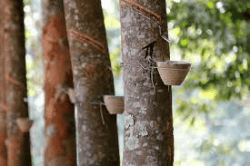Rubber is a natural material obtained from rubber trees. The production process of rubber takes around 32 years, with a seven-year immature stage followed by a 25-year productive phase. The trees need well-drained, weathered soil, and non lateritic red or alluvial soil for optimal growth. Rubber trees are grown commercially by cultivating high-yielding clones. These clones are more fertile than the original tree and are capable of yielding more latex.

The early 20th century saw the introduction of the automobile and bicycle, which increased the demand for rubber. The advent of the pneumatic tyre and solid tyre made this material an essential component of these new products. Around half of the world’s natural rubber came from Central and South Africa. In 1900, the production of natural rubber in these countries was only one kilogram per hectare.
Rubber is made up of elastomers, natural and synthetic, which have elastic properties and are resistant to pressure and stretching. Its properties make it popular for many wet applications. While water-proof rubber rejects liquid completely, water-resistant rubber offers strong protection against liquids, but is not totally impervious.
Smallholders collect rubber from trees far from the nearest factory. They tap the trees on their way to work and collect the latex on their way home. By the time the latex reaches the factory, it would already be coagulated. Consequently, the process of collecting latex in this manner is not a simple process.
The rubber processing industry was a major threat to rural communities. To avoid further degrading rural life, the rubber industry needed to develop a sustainable water policy and implement effective wastewater management and treatment practices. The water supply of these industries was threatened due to over-exploitation. However, there were solutions to the problems by implementing sustainable water management and the recycling of wastewater.
A good example of how rubber is used in the water industry is in wastewater treatment. This industry uses this material for water treatment because it prevents leaks and reduces operating costs. It also protects the environment by eliminating environmental risks. For more information on Rubber Moulding UK, go to a site such as www.meadex.co.uk/rubber-moulding

Water filtration systems are another common use of rubber in the water industry. The metal gate seals in industrial water filtration systems are secured by metal frames. The gates and frames are connected through rubber gaskets. The rubber gaskets must be able to withstand long-term exposure to water and mechanical stress from tightening fasteners. In addition, they must withstand abrasive contact with concrete frames. They also need to be UV-resistant.

